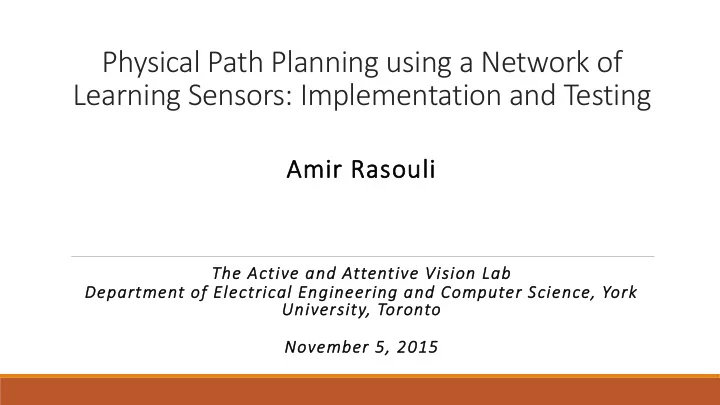

Physical Path Planning using a Network of Learning Sensors: Implementation and Testing Amir Rasouli The Active and Attentive Vision Lab ab Department of Electrical Engineering and Computer Science, York University, Toronto November 5, 2015
Swarm of Interacting Reinforcement Learners (SWIRLs) • A physical path planning approach • Network of sensors interacting to learn the best path • Robots ask sensors where to go next www.flickr.com
SWIRLs Environments
SWIRLs Stages of Operation • Initialization 𝑅 𝑦 𝑦, 𝑦 = 0 𝑅 𝑦 𝑜, 𝑜 = 𝐹𝑡𝑢. 𝑜 𝐼𝐹𝑀𝑀𝑃(𝑜 𝑞𝑝𝑡 ) 𝑜 → 𝑂(𝑦) x 𝐼𝐹𝑀𝑀𝑃(𝑒 𝑞𝑝𝑡 ) 𝐼𝐹𝑀𝑀𝑃(𝑦 𝑞𝑝𝑡 ) … d n … 𝐼𝐹𝑀𝑀𝑃(𝑜 𝑞𝑝𝑡 )
SWIRLs Stages of Operation • Initialization ∗ 𝑒, 𝑒 + 𝑅 𝑦 𝑜, 𝑜 → 𝑅 𝑦 𝑜, 𝑒 𝑅 𝑜 • Estimation 𝑒 → 𝑊 𝑦 x 𝐹𝑇𝑈𝐽𝑁𝐵𝑈𝐹( 𝑒𝑤[𝑒]) ∗ 𝑦, 𝑦 + 𝑅 𝑒 𝑜, 𝑜 → 𝑅 𝑒 (𝑜, 𝑦) 𝑅 𝑜 𝑦 → 𝑊 𝑒 d n 𝐹𝑇𝑈𝐽𝑁𝐵𝑈𝐹( 𝑒𝑤[𝑦])
SWIRLs Stages of Operation • Initialization 𝑈𝐵𝑆𝐻𝐹𝑈(𝑜) • Estimation 𝑢𝑗𝑛𝑓𝑠 𝑢: 𝑡𝑢𝑏𝑠𝑢 • Query Δ x 𝑅𝑉𝐹𝑆𝑍(𝑒) d n
SWIRLs Stages of Operation • Initialization • Estimation • Query x • Update 𝑉𝑄𝐸𝐵𝑈𝐹(𝑜, 𝑢) d Δ n 𝑢𝑗𝑛𝑓𝑠 𝑢: 𝑡𝑢𝑝𝑞
Implementations • Sequential Implementation • All processing and message passing is on a single thread • Semi-multi-threaded • Sensors and message passing on a single thread • Robots are run on individual threads • Multi-threaded • Sensors and robots are run on individual threads • Communication is through shared memory
Code Structure
Sequential Controller package swirl; public class SwirlSequential { private final List<SensorSeq> sensorsList = new ArrayList<SensorSeq>(); private final List<RobotSeq> robotsList = new ArrayList<RobotSeq>(); … public void execute() { initialize(); List<Message> robotsRequestList = new ArrayList<Message>(); Map<Character, Message> targetList = new HashMap<Character,Message>(); … while ( true ) { if (timer(…)) { estimate();} for ( int rIdx = 0; rIdx < this .robotsList.size(); rIdx++) { robotsRequestList.add( this .robotsList.get(rIdx).operate( …) ); } … for ( int m = 0 ; m < robotsRequestList.size(); m++) { … targetList.add(sensorsList.get( … ).receive(robotsRequestList.get(m))); } } }
Semi-Multi-Threaded Controller package swirl; public class SwirlSemiMultiThreaded { private final ConcurrentMap<Character, Message> targetList = new ConcurrentHashMap<Character,Message>(); private final BlockingQueue<Message> robotsRequestList = new ArrayBlockingQueue<Message>(SwirlController. NUMBER_OF_ROBOTS *2); … public void execute() { … setThreads(); BlockingQueue<Message> rejectList = new ArrayBlockingQueue<Message>(SwirlController. NUMBER_OF_ROBOTS ); while ( true ) { if (timer(…)){...} while (!robotsRequestList.isEmpty()) { … if (targetMsg.targetId == -1) { rejectList.offer( … ); } … } while (!rejectList.isEmpty()) { this .robotsRequestList.offer(rejectList.poll()); } } } }
Multi-Threaded Controller package swirl; public class SwirlMultiThread { private final Map<Integer,BlockingQueue<Message>> initList = new HashMap<Integer,BlockingQueue<Message>>(); private final Map<Integer,BlockingQueue<Message>> estList = new HashMap<Integer,BlockingQueue<Message>>(); private final Map<Integer,BlockingQueue<Message>> queryList = new HashMap<Integer,BlockingQueue<Message>>(); private final Map<Integer,BlockingQueue<Message>> updateList = new HashMap<Integer,BlockingQueue<Message>>(); private final ConcurrentMap<Character, Message> targetList = new ConcurrentHashMap<Character,Message>(); … public void execute() { … setThreads(); … }
Graphics
Multi-Threading in Graphics2D SwingWorker<Boolean, DrawSensor> worker = new SwingWorker <Boolean, DrawSensor>() { protected Boolean doInBackground() throws Exception { … DrawSensor s = new DrawSensor( … ); publish(s); return true ; } protected void process(java.util.List<DrawSensor> chunks) { frame.getContentPane().remove( … )); graphics.put(( char )selfId,frame.getContentPane().add(chunks.get(chunks.size()-1))); frame.revalidate(); frame.repaint(); } }; worker.execute();
Simulation Sensor Robot 25 25 25 Uninitialized Default Estimate E = ID 44 = Destination
Sequential Run
Sequential Run
Sequential Run
Sequential Run
Sequential Run
Sequential Run
Multi-Threaded Run
Multi-Threaded Run
Multi-Threaded Run
Multi-Threaded Run
Multi-Threaded Run
Multi-Threaded Run
Testing • Functionality • System behaves as expected • Fault-free • E.g. DeadLock, ConcurrentModification and NullPointer exceptions • Performance • What is the best concurrent structure • General Purpose Test • Unexpected issues
Functionality • Case 1 : Sensors get to know all other sensors • Random experiments with 4-10 robots and 10-300 sensors • Case 2: Learning • Full learning hard to measure • Run the same experiments multiple times 20 runs with identical configuration using 4 robots and 1280 sensors
Fault-free • Deadlock caused by BlockingQueue • Null return from the queues • Concurrent modification of Maps • Ongoing detection by setting up all possible scenarios
Performance • Case 1: Code Structure, Number of Robots • e.g. order of message 5 6 7 8 9 10 11 handling 60 0.114 -11.307 0.031 0.29 -12.925 0.291 0.052 Number of sensors 100 0.36 -4.494 1.035 0.473 1.105 0.894 0.346 • Timing of estimates 140 1.277 2.064 1.866 1.383 -2.63 1.489 10.5 180 1.219 2.172 7.268 2.193 2.145 -9.714 6.359 • Case 2: Handling Concurrency 220 2.088 4.8 -8.025 -6.699 2.815 1.325 9.11 • ConcurrentMap is more 260 7.564 1.671 12.176 2.793 9.035 -7.868 2.568 efficient than 300 2.11 5.361 5.425 4.296 24.26 3.231 6.889 Collection.Synchronized() The results are obtained by subtracting single channel running times from the corresponding four channel trials • Single-Channel vs Four- Channel Communication no significant difference
Unexpected problems • Over 300 of experiments • Various systems • Intel Xeon 2.67 GHz with 24 single-threaded cores • Intel I7 2.00 GHz with 2 double-threaded cores • Intel Xeon 2.66 GHz with 8 single-threaded cores • Systematic change of parameters • Number of sensors • Number of robots • Maximum Speed of robots • Timing of estimate steps
Future Work • Measure the performance of each implementation • Observe how each method scales to the size of the system
Recommend
More recommend